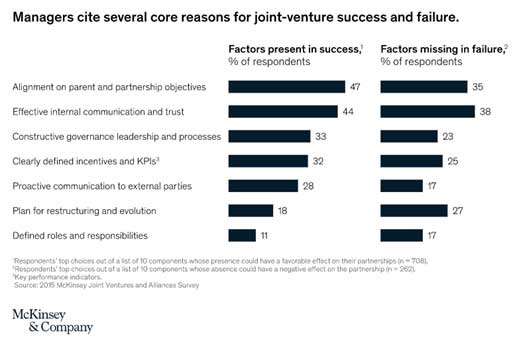Thinking about getting into a strategic alliance? Learn more about this popular type of partnership and how to make it work for your business.

Strategic alliances are when two or more businesses enter into an agreement to work together toward a common goal, while still remaining independent.
This type of partnership enables you to pool resources, leverage your combined expertise, and go further as a team than either of you could go alone. A strategic alliance is a win-win for both sides.
While strategic alliances offer a lot of benefits, they do come with some inherent risks. It’s important to understand the basics of the business agreement and what you’re getting into when creating a strategic alliance.
In this article, we delve into what strategic alliances are, the three different types of strategic alliances, and how to create an effective strategic alliance that gets results.
What is a strategic alliance?
A strategic alliance is a partnership between two businesses to achieve mutual goals and growth, while still retaining independence. Such partnerships are usually long-term in nature, with each business bringing its expertise and resources to the table.
But not all alliances are considered “strategic.” There are five accepted criteria to check whether or not a potential partnership is strategic for your business. Meeting even one of these criteria can qualify as a strategic alliance:
1. The partnership is essential to the achievement of the main business objective. In other words, engaging or not-engaging in the alliance will significantly impact whether or not the objective is successfully met.
2. The partnership is indispensable in creating or maintaining any business aspect that functions as a competitive advantage.
3. The partnership cements the ability to overcome competitor threats.
4. The partnership builds, supports, or maintains strategic decision-making.
5. The partnership significantly reduces risk.
Why are strategic alliances so popular?
Strategic alliances have become a popular way to grow businesses. In Strategic Partnerships by Robert L. Wallace, he outlines three reasons why this type of partnership works so well:
The customer is king
Customers today are aware, informed, and discerning. With everything at their fingertips, customers can learn everything about your company and purchase any given product or service in a few clicks.
To compete effectively in the marketplace, businesses have to not just meet, but exceed customer expectations. Businesses can engage customers in a new way through a strategic alliance that enables them to create more competitive offerings and expand into a new audience.
Big doesn’t necessarily mean better
Technology has helped bridge the gap between small businesses and corporations, allowing companies of all sizes to form strategic alliances with one another.
For example, a startup can offer expertise that benefits a larger company, while a larger company has the established reach and resources a startup needs. Now more than ever, we’ve seen a range of successful strategic alliances and the trend will only continue to grow.
Global connectivity
Another effect of technology is that time and distance is now irrelevant. The rise of diversity and shifting population across countries has encouraged businesses to enter strategic alliances as a way to reach new audiences and gain insight into global markets and operations.
And with so many new software platforms, it’s become easier to work with remote teams and expand your business to new markets.
3 different types of strategic alliances
There are three main types of strategic alliances: a joint venture, an equity strategic alliance, and a non-equity strategic alliance.
1. Joint ventures (JV)
In a joint venture, two companies come together to form a third distinct legal business entity – a “child” company – by means of a binding contract .
One example is Tata Starbucks, a JC between Starbucks Corporation and Tata Global Beverages, the world’s second largest tea producer. In 2012, the two beverage giants partnered together with 50-50 ownership to leverage their individual brands of coffee and high-quality tea and coffee.
2. Equity strategic alliances
In an equity strategic alliance, one partner purchases equity in another company. Alternatively, both partners can also purchase equity in each other’s companies.
Panasonic’s $30 million investment in Tesla is a good example of an equity strategic alliance. Along with the purchase of Tesla stock, Panasonic also brought its cutting edge battery cell technology to the partnership.
While Tesla was already using Panasonic batteries on its vehicles, the equity strategic alliance further helped Panasonic in its mission to be the number one green innovation company in the electronics industry.
3. Non-equity strategic alliances
In a non-equity strategic alliance, partners pool resources toward a mutual business objective in a more informal agreement. There are no child entities or shared equity. For this reason, non-equity strategic alliances are one of the most common.
Popular non-equity strategic alliances are distribution partnerships. For example, Fedex teamed up with BigCommerce to provide quick and convenient delivery for ecommerce customers.
Business owners who use BigCommerce have access to FedEx ecommerce solutions, which include four months of free shipping service and significant shipping discounts afterward. In exchange, Fedex enjoys brand presence on the growing network of BigCommerce stores.
Advantages of a strategic alliance
Strategic alliances offer the core advantages of increasing resources, accessing new markets, growing brand awareness, and more. Below are some of the top strategic alliance advantages:
Increased resources
Strategic alliances enable businesses to gain access to supplementary resources in the form of knowledge, products, or other assets without changing their core functions.
Every business has its own expertise and most prefer to stick to their core competencies. Being able to share the best of what each one has to offer and turn them into something greater than the sum of its parts can take business relationships to exponentially greater heights.
Plus, what you learn from another company’s expertise can often be adapted and applied to your own business.
Access to new markets
One of the most popular reasons to enter into strategic alliances is to gain access to another market. This is especially common when a new product, event, or campaign is being launched.
Offering something new together with a partner creates a sense of excitement and exclusivity, which can help with market penetration for both businesses.
Expanded customer base
In a strategic alliance, it’s typical for businesses to be publicly mentioned by their partner. In fact, businesses often choose partners based on their local presence or position in another market.
The added exposure brought by a strategic alliance offers both businesses a larger customer base they may not have been able to reach alone.
Agile growth
A strategic alliance brings the benefit of having double the manpower, skillset, knowledge, and more. Reaching your objectives can instantly be done much quicker and more efficiently.
However, since the costs and risks are also shared, the informal nature of a strategic alliance makes it a good way to explore an idea in a shorter time frame, at significantly lower costs. (See more agile marketing ideas here.)
Greater brand awareness
With an expanded customer base and growth into new markets, strategic alliances have the added advantage of building brand awareness. Partnering with a business that has a positive reputation can also enhance your own through association.
Disadvantages of a strategic alliance
On the surface, a strategic alliance looks like a great business strategy to scale quickly with minimal risk.
However, this isn’t always the case. Strategic alliances come with their own set of challenges, which you should be aware of when considering this type of partnership:
Search for the right partner
Most of the work involved in setting up a strategic partnership is in engaging with the right partner. Take your time to choose a partner with the same values, vision, and most importantly, the commitment to making the best of the relationship.
Can they give an equal amount of time and resources? Do they have a positive reputation? If you don’t see eye to eye with your partner, you may encounter some difficulties working together in a strategic alliance.
Unable to let go of control
Letting go of some control is necessary for a strategic partnership to be effective. You’re agreeing to share resources and responsibilities, and different businesses do things in different ways. (This can be more pronounced when partners are from different countries or cultures.)
Bring up any new ideas and set clear expectations at the start. Then, maintain open lines of communications to ensure the partnership is progressing on the right track.
At the end of the day, a strategic alliance is not just about you – it’s about getting the best for both parties involved.
Lack of transparency
Strategic alliances require both parties to share certain amounts of information and resources. To do this, establishing a foundation of mutual trust and faith is essential.
Sometimes, a business may not represent itself accurately and deliberately hide or misrepresent aspects that could have considerable bearing on the partnership. Or a partner may start out with a high level of enthusiasm, but isn’t able to maintain that level of dedication throughout the partnership.
In cases like these, the other partner may feel misled and no longer see value in the relationship.
Increase in liability
Strategic alliances can increase the level of liability for all stakeholders. If one business mismanages its resources, lands in financial trouble, or fails to hold up their end of the bargain, its partner can also suffer as a result.
Even if a business experiences difficulty outside the parameters of the strategic alliance, if it affects the strategic alliance in any way, the partner may also be responsible for sharing the burden of any liability.
How do you create a strategic alliance?
Strategic alliances are a great way for businesses to pool resources together and experiment in new markets. If you’ve been thinking of entering into a strategic alliance, it’s important to take the proper steps that will set you up for success.
Here are some general steps to guide you in setting up a successful strategic alliance from the get-go:
Step 1: Assess the market and validate your idea
Before even looking for a strategic partner, it’s important to do an initial assessment of the business environment, target market, and validate your idea.
Start by coming up with the best possible product or solution that can be provided, the best possible product or solution you can offer, and what you need to bridge any gaps between the two.
What you identify in the gap between both solutions (what can be provided and what you can offer) is essentially what your partner should be able to help you with.
Step 2: Choose the right partner
The next step is identifying the right strategic partner. Here are some questions to ask to narrow down your best choices:
- What are the key traits you’re looking for in a partner?
- What value do you expect from the potential partner? (The more you can quantify this, the better.)
- How much risk do you see coming from the potential partner?
- Do you share the same values, vision, and goals? Are your corporate/management structures compatible with each other?
- Does the partner have previous experience in partnerships? If so, have you reviewed their track record and performance?
- Have you thoroughly researched the potential partner’s reputation, profitability, and expertise? (You can do this through referrals, your own research, and advice from experts in the industry.)
- How long do you see the engagement lasting?
- Can the partner connect you to other potentially beneficial organizations in their network?
Step 3: Initial meeting with the potential strategic partner
Once you’ve done the groundwork and have a solid understanding of your partner’s business and how you can work together, it’s time to connect.
Send your proposition across to the key stakeholders and set up a time to discuss it in detail. Remember, strategic alliances are supposed to be win-win relationships. So your proposal should include what value they will get in forming a partnership with you.
In general, an kickoff meeting should cover:
- Your market assessment, validation process, and the results and insights
- A detailed roadmap and implementation model, based on your market validation
- Revenue/profit objectives, and specific strategies and resources needed to achieve them
- The strengths you bring to the partnership
- What will be expected from each partner throughout the relationship
After your presentation, leave the floor open for any feedback or suggestions from your potential partner. Be open to discussing other potential opportunities they may have in mind.
Based on the meeting, both businesses can assess if there’s an opportunity to go forward and close the deal. Sometimes, this requires a little back-and-forth to iron out all the details based on feedback from both businesses.
Step 4: Formalize the strategic alliance
Once both parties are aligned and agree to move forward, it’s time to formalize your strategic alliance. Draw up an agreement to should cover the following:
- A detailed roadmap and duration of the partnership
- Key points of contact from each party
- Expectations and resources required from either party (include any proprietary information, confidentiality clauses, or non-disclosure agreements)
- Metrics and accountability measures
- Management protocol and structure of the relationship
- Key milestones and meeting schedules
- Any cases in which the partnership can be ended
- Other rules of engagement (see below)
It’s best to have all documents reviewed by your legal team and key stakeholders.
Bonus strategic alliance tips: Rules of engagement
Strategic alliances are all about creating a win-win relationship for both parties. You need to nurture the relationship, keep track of how it’s doing, and adjust and realign when needed.
The chart below, based on a survey by McKinsey & Company, provides insight into the factors present in successful strategic alliances, as well as the factors missing in failed ones:

 All 4 One Alliance Legal
All 4 One Alliance Legal